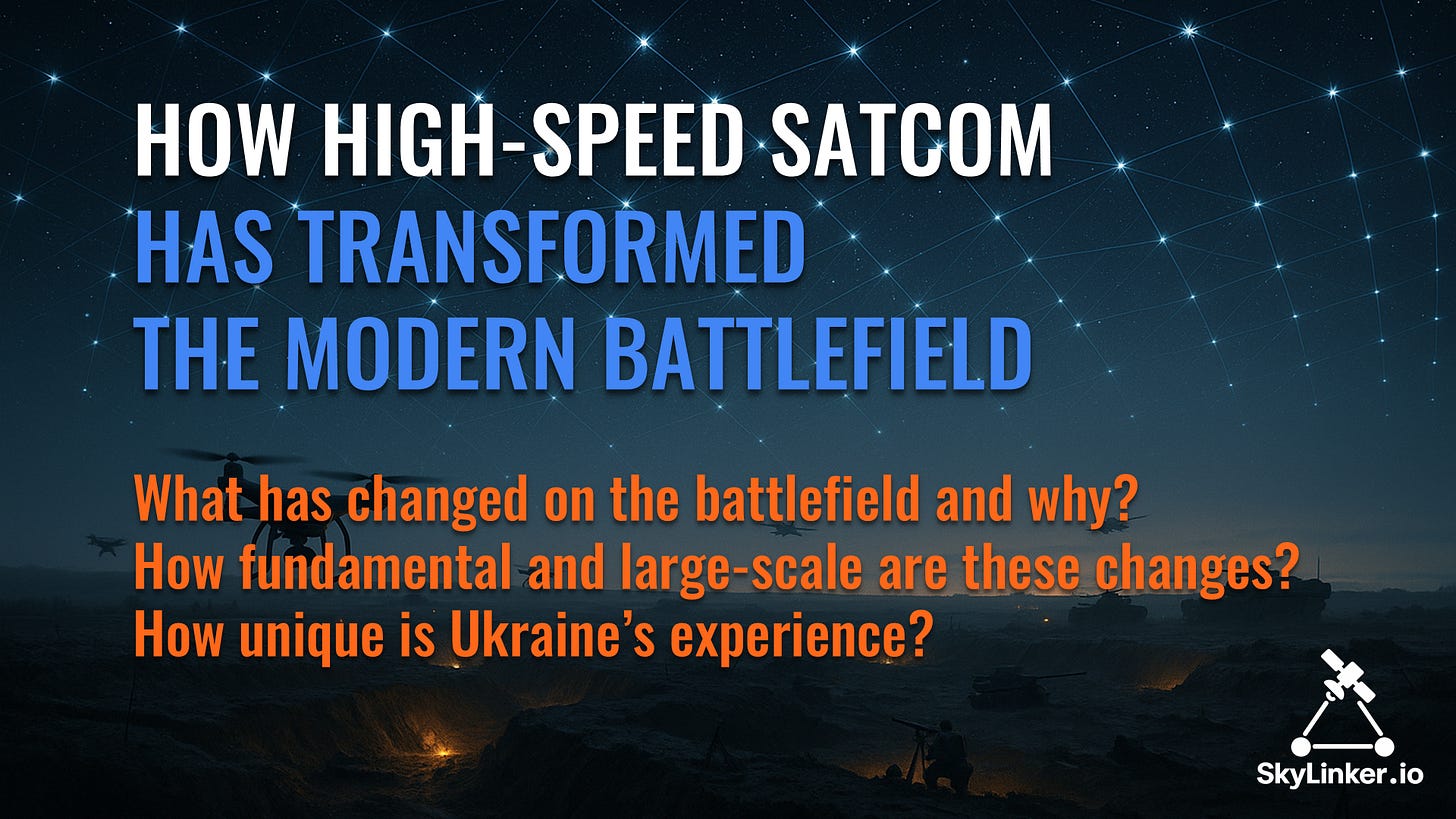How High-Speed Satellite Communication Has Transformed the Modern Battlefield
What has changed on the battlefield and why? How fundamental and large-scale are these changes? How unique is Ukraine’s experience?
A brief overview of the causes and consequences of the evolution of communications, which have radically changed the rules on the modern battlefield not only in Ukraine. This material is presented as an introduction to more technical analytical publications to follow.
On February 24, 2022, the most powerful military invasion began — a grouping of Russian armed forces invaded Ukraine. The day before, a hacker attack disabled terminals of the most widespread satellite communication network in this part of Europe at the time. The aggressor deployed its powerful electronic warfare (EW) component, successfully attacked civilian telecommunications infrastructure, and expected Ukraine’s defenders to almost completely lose command and control. But things turned out differently…
The fact that Russia’s ambitious plans failed to materialize is primarily the merit of Ukrainians themselves and their desperate national resistance. For more than three years, technological factors have been radically transforming the means of warfare, breaking away from academic concepts that still dominate militaries around the world.
What has changed on the battlefield?
The typical structure of traffic in military networks has long included familiar data — from C2 messages, exchanges between command-and-control systems and situational awareness platforms, to logistical and administrative flows. It also included intelligence streams (SIGINT, ISR, and others), as well as technical service data, including telemetry. Yet one crucial component remained underdeveloped — real-time video streams and sensor telemetry.
Previously, satellite communications relied primarily on geostationary (GEO) satellites. The main technical limitation of such systems has been their low bandwidth and high signal latency. Using them “on the move” required solutions costing tens or even hundreds of thousands of dollars. This created a low “ceiling” of throughput capacity, which many armies around the world — and even defense industry suppliers — still use as a reference point.
The scale and dynamics of combat in Ukraine have clearly demonstrated: traditional communication infrastructures do not meet modern needs. Russia’s advanced signals intelligence (SIGINT) and electronic warfare (EW) systems create a constantly shifting environment where conventional systems become unreliable. The flexibility and geographic reach of satellite communications held immense potential, but it had not been realized on the necessary scale.
And then came Elon Musk’s project — Starlink. It was not only a technological breakthrough but also destroyed the pricing barriers of the industry. High bandwidth, affordability, scalability, and ease of use made it widespread. Ukrainians quickly harnessed this potential.
The use of drones in warfare can be divided into the eras of “before 2022” and “after 2022.” In every scenario, the critical factor is transmitting video, telemetry, and command signals in real time. The scale of combat in Ukraine proved that no other system can meet these demands. It was Starlink that provided the “quantum leap” enabling the mass deployment of unmanned solutions. This is truly the era of “before Starlink” and “after Starlink.”
The Unrecognized Scale of Change
The number of active Starlink terminals in Ukraine has long surpassed 200,000. That is more than in the rest of the European continent combined. Over three years, extensive integration processes took place, without which effective use at this scale would have been impossible. It is precisely this integration and scaling that became the decisive factor.
The result was a qualitative leap in battlefield command and control. Reconnaissance, re-tasking, and targeting capabilities increased enormously. But most importantly, the mass use of precision-guided weapons emerged, leading to the conflict being labeled a “drone war.” Additionally, it proved critical that the aggressor was unable to jam Starlink with its EW systems.
The ability to transmit and process massive volumes of video and sensor data in real time has changed military operations at every level — from tactical to strategic. This is what opened the path to the “drone war.”
The drawback, of course, is critical dependence on a single system — Starlink. Without delving into technical or political aspects, the key point is that another trend is already emerging in Ukraine: the hybridization of communications.
Potential and Prospects
The hybridization of communication systems means developing solutions that enable the use of the entire spectrum of communication channels in any scenario. This requires unifying technologies and processes, but it is this very unification that will form the foundation of tomorrow’s military communications.
It is worth emphasizing: Ukraine’s experience in scaling satellite communications has already delivered major innovations. Together with hybridization, it promises even more. This includes adapting terminals not designed for battlefield use to tactical and operational scenarios. It includes integration into critical technological systems. It also involves exploring alternatives — from existing solutions to the development of Ukraine’s own terminals and even satellite constellations.
Clearly, we stand at the threshold of a qualitative global transition in military communications. A new domain of competencies is opening up, one relevant to any country seeking to adapt its defense potential to modern threats. Ukraine is already on the path to leadership, thanks to both its hard-won experience and its technological trajectory. This experience is already attracting international attention and deserves careful adaptation by others.
In the future, SkyLinker will continue to publish analyses with deeper technical insights into these aspects. For those interested in more in-depth analytics, developing informational or training materials, or conducting seminars — you can reach out at volodymyr@stepanets.eu.


